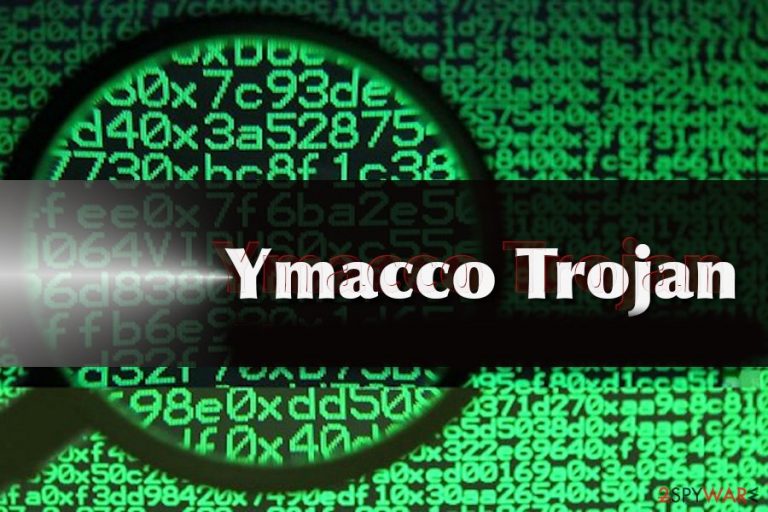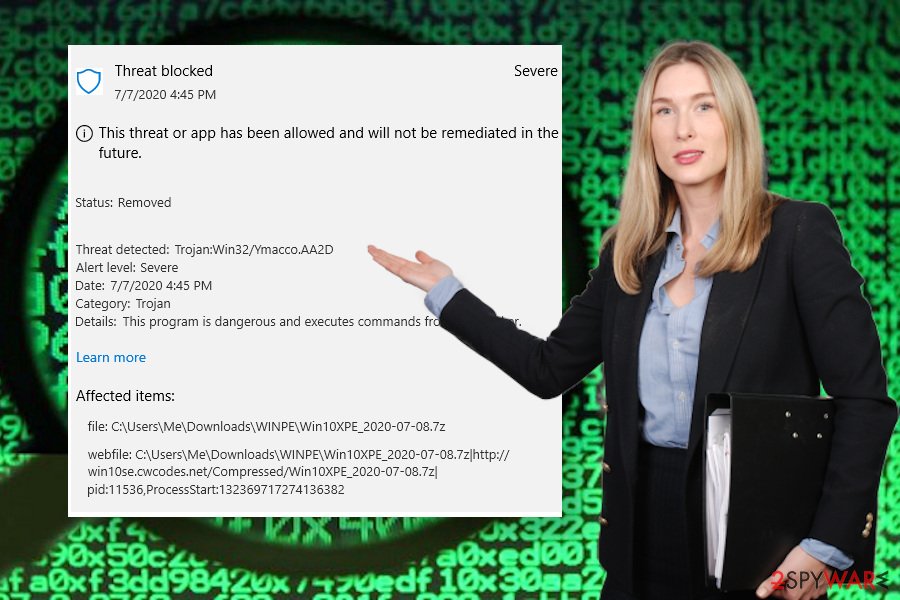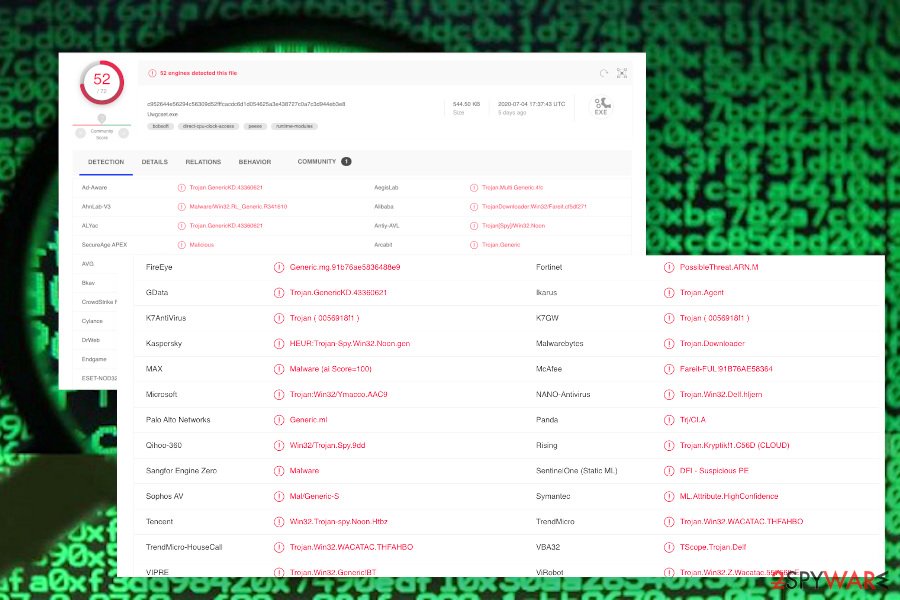Trojan:Win32/Ymacco (Improved Instructions) - 2021 update
Trojan:Win32/Ymacco Removal Guide
What is Trojan:Win32/Ymacco?
Ymacco Trojan is a piece of malware that can open backdoors and expose users to malicious websites

Trojan:Win32/Ymacco is a is a highly dangerous cyber infection that aims at injecting malicious scripts on the infected machines, downloading other dangerous programs, manipulating system's performance, rerouting users' traffic to compromised websites, and more. In short, it can initiate various risk-posing performances on the host machine, so an ASAP removal is recommended.
This trojan[1] has been designed in a sophisticated manner, which is why it is capable of infecting machines stealthily via spam emails, pirated software, cracks, and similar content. Upon installation, it starts running malicious processes, one of the most prominent of which is Uwgcset.exe. Usually, this process is highly obfuscated to prevent detection. Nevertheless, a full scan with a professional AV tool usually ends up warning users about the Trojan:Win32/Ymacco.AAC9, Win32/TrojanDownloader.Delf.CYB, Trojan.GenericKD.43360621, and similar detection.
Unfortunately, the Ymacco virus is extremely deceptive as it does not give its presence straightforwardly. It can hide in the system for quite a while unnoticed until the user spot high CPU usage by suspicious files, unfamiliar files within random folders, web-browser redirects to sites like z.whorecord.xyz, a.tomx.xyz, pushwelcome.com, pushtoday.icu, and others. Malware like this can cause serious issues, such as spyware or ransomware infiltration, so make sure to remove the Trojan without a delay.
| Name | Ymacco Trojan |
| Type | Trojan |
| Danger | This trojan poses a risk to the users of infected machine by initiating regular redirects to infected web domains, running malicious processes in the background, and downloading other malware to the system |
| Detection |
|
| Symptoms | The Trojan runs malicious processes in the background and triggers high CPU consumption. Besides, it may hijack web browsers and redirect the traffic to sites infected by malicious scripts |
| Removal | Malicious files get hidden in various system locations and often disguised under legitimate Windows files/processes. Therefore, a full system scan with a professional AV tool is required for the proper Ymacco trojan removal |
| Fixing the damage | A scan with FortectIntego tool is recommended since such tools like PC repair or system applications can repair the affected system's settings, files, and processes. Full optimization is required to prevent issues in the future |
This trojan is often dubbed as Trojan:Win32/Ymacco.AAC9 on the basis of the AV detection brought by Windows Defender. Nevertheless, it's internationally known as the backdoor or trojan virus due to the traits that it has.
- The malicious trojan loader Uwgcset.exe infiltrates machines without being noticed as a component of a malicious spam email attachment or pirated software like cracks or keygens;
- Upon infiltration, it extracts the trojan package and starts running various malicious entries on the Startup and Task Manager;
- It misuses CPU, which is why the system's performance decreases significantly;
- It aims at weakening the system's performance to open the backdoor and enable access to other malicious software.
- It creates persistence to avoid detection and removal. Often the processes of AV programs are disabled.
- The Ymacco Trojan virus can inject malicious scripts within web browsers to open malicious websites;
Experts from Virusai.lt[3] claim that a regular system scan with a reputable AV engine is a must to ensure that the system is virus-free. Keep in mind that Trojans like the Ymacco virus are difficult to detect because they do not manifest themselves easily, so no scanning the machine on regular basis can mean a long persistence to the virus.
At the moment, a successful Ymacco trojan removal can be initiated with 52 most reputable AV tools as they have crucial updates required for the detection of this pest. Note that the detection may differ regarding the application that you are using, so if you want to be clear if this particular trojan is hiding on your machine, you can check the VirusTotal provided detection names for it.

The good news is that the virus is not a spyware or banking trojan. It means that it does not seek to steal your passwords or other credentials. It's primary task – weaken PC's security and increase vulnerability. After that, it exposes the user of an infected machine to the malicious domains, thus posing a high-risk of malware downloads.
The bad news is that Ymacco trojan redirects can expose you to sites like z.whorecord.xyz, a.tomx.xyz, and others that are infamous for click-to-download malware distribution, infected software updates, click-bait ads, and other social engineering strategies.
Therefore, make sure to remove Ymacco Trojan as soon as possible. For this purpose, take advantage of a powerful anti-virus program and run its scan after restarting Windows into Safe Mode with Networking.
As we've already pointed out, a scan with an AV engine will not repair damaged system files. Thus, tight after the Ymacco virus removal, download FortectIntego or similar repair tool and set it to fix all detected system issues.
Malicious code disguised under file attachments can deliver trojans
The source of trojans cannot be specified because there are many. Criminals are using various techniques to make people slip on downloading malicious entries to their machines, so the only precautionary measure is to be careful when browsing online and keeping the machine fully protected by AV programs.
Nevertheless, there are several methods that are known to be the primary trojan download sources. First of all, malicious codes are frequently hidden in spam email attachments. People may get fake email messages that supposedly contain financial information, receipts, invoices, order confirmations, and so on. Such emails may be professionally crafted, though usually, they contain grammar, typo, and logic mistakes.

Apart from spam, people may be tricked into downloading trojans by downloading illegal content from P2P networks, torrenting sites, or other pirating sources. Hackers can easily inject malicious scripts into various cracks, keygens, third-party games, etc.
Trojans are also often distributed via infected links that people receive on social media. For instance, the well-known Facebook virus has been, and probably still is, the most successful malware distribution campaign. Therefore, do not trust suspicious content even if it comes from a trusted source.
Remove Trojan:Win32/Ymacco to protect the system from malware
There is a sole technique that is fully functional in dealing with viruses like Ymacco trojan. That's a thorough system scan with a robust anti-malware tool. Since this virus is highly dangerous in its nature as it poses a risk to the user's privacy and the system's security, it has to be fully eliminated.
Employing a professional anti-malware for Ymacco trojan removal gives the advantage of cleaning other cyber infections at the same time. If you are not sure when the machine has been infected, there's a risk that it has been running for a long time already and might have downloaded a bunch of malicious files.
Rely SpyHunter 5Combo Cleaner or Malwarebytes tools for checking the system and performing a full Ymacco trojan removal. If you cannot launch the security tool, try to restart Windows into Safe Mode with Networking (a guide provided below). Finally, do not underestimate the need for the system's optimization. Download FortectIntego and scan the machine to restore all files that the trojan might have damaged or removed.
Getting rid of Trojan:Win32/Ymacco. Follow these steps
Manual removal using Safe Mode
The Trojan:Win32/Ymacco.AAC9 detection is a signal that the system is infected with a Trojan and has to be cleaned to prevent various issues. For this purpose, restart the machine into Safe Mode and run a full system scan as explained below:
Important! →
Manual removal guide might be too complicated for regular computer users. It requires advanced IT knowledge to be performed correctly (if vital system files are removed or damaged, it might result in full Windows compromise), and it also might take hours to complete. Therefore, we highly advise using the automatic method provided above instead.
Step 1. Access Safe Mode with Networking
Manual malware removal should be best performed in the Safe Mode environment.
Windows 7 / Vista / XP
- Click Start > Shutdown > Restart > OK.
- When your computer becomes active, start pressing F8 button (if that does not work, try F2, F12, Del, etc. – it all depends on your motherboard model) multiple times until you see the Advanced Boot Options window.
- Select Safe Mode with Networking from the list.

Windows 10 / Windows 8
- Right-click on Start button and select Settings.

- Scroll down to pick Update & Security.

- On the left side of the window, pick Recovery.
- Now scroll down to find Advanced Startup section.
- Click Restart now.

- Select Troubleshoot.

- Go to Advanced options.

- Select Startup Settings.

- Press Restart.
- Now press 5 or click 5) Enable Safe Mode with Networking.

Step 2. Shut down suspicious processes
Windows Task Manager is a useful tool that shows all the processes running in the background. If malware is running a process, you need to shut it down:
- Press Ctrl + Shift + Esc on your keyboard to open Windows Task Manager.
- Click on More details.

- Scroll down to Background processes section, and look for anything suspicious.
- Right-click and select Open file location.

- Go back to the process, right-click and pick End Task.

- Delete the contents of the malicious folder.
Step 3. Check program Startup
- Press Ctrl + Shift + Esc on your keyboard to open Windows Task Manager.
- Go to Startup tab.
- Right-click on the suspicious program and pick Disable.

Step 4. Delete virus files
Malware-related files can be found in various places within your computer. Here are instructions that could help you find them:
- Type in Disk Cleanup in Windows search and press Enter.

- Select the drive you want to clean (C: is your main drive by default and is likely to be the one that has malicious files in).
- Scroll through the Files to delete list and select the following:
Temporary Internet Files
Downloads
Recycle Bin
Temporary files - Pick Clean up system files.

- You can also look for other malicious files hidden in the following folders (type these entries in Windows Search and press Enter):
%AppData%
%LocalAppData%
%ProgramData%
%WinDir%
After you are finished, reboot the PC in normal mode.
Remove Trojan:Win32/Ymacco using System Restore
-
Step 1: Reboot your computer to Safe Mode with Command Prompt
Windows 7 / Vista / XP- Click Start → Shutdown → Restart → OK.
- When your computer becomes active, start pressing F8 multiple times until you see the Advanced Boot Options window.
-
Select Command Prompt from the list

Windows 10 / Windows 8- Press the Power button at the Windows login screen. Now press and hold Shift, which is on your keyboard, and click Restart..
- Now select Troubleshoot → Advanced options → Startup Settings and finally press Restart.
-
Once your computer becomes active, select Enable Safe Mode with Command Prompt in Startup Settings window.

-
Step 2: Restore your system files and settings
-
Once the Command Prompt window shows up, enter cd restore and click Enter.

-
Now type rstrui.exe and press Enter again..

-
When a new window shows up, click Next and select your restore point that is prior the infiltration of Trojan:Win32/Ymacco. After doing that, click Next.


-
Now click Yes to start system restore.

-
Once the Command Prompt window shows up, enter cd restore and click Enter.
Finally, you should always think about the protection of crypto-ransomwares. In order to protect your computer from Trojan:Win32/Ymacco and other ransomwares, use a reputable anti-spyware, such as FortectIntego, SpyHunter 5Combo Cleaner or Malwarebytes
How to prevent from getting trojans
Do not let government spy on you
The government has many issues in regards to tracking users' data and spying on citizens, so you should take this into consideration and learn more about shady information gathering practices. Avoid any unwanted government tracking or spying by going totally anonymous on the internet.
You can choose a different location when you go online and access any material you want without particular content restrictions. You can easily enjoy internet connection without any risks of being hacked by using Private Internet Access VPN.
Control the information that can be accessed by government any other unwanted party and surf online without being spied on. Even if you are not involved in illegal activities or trust your selection of services, platforms, be suspicious for your own security and take precautionary measures by using the VPN service.
Backup files for the later use, in case of the malware attack
Computer users can suffer from data losses due to cyber infections or their own faulty doings. Ransomware can encrypt and hold files hostage, while unforeseen power cuts might cause a loss of important documents. If you have proper up-to-date backups, you can easily recover after such an incident and get back to work. It is also equally important to update backups on a regular basis so that the newest information remains intact – you can set this process to be performed automatically.
When you have the previous version of every important document or project you can avoid frustration and breakdowns. It comes in handy when malware strikes out of nowhere. Use Data Recovery Pro for the data restoration process.
- ^ What is a Trojan Virus?. Kaspersky. Official website of software developer.
- ^ Detection rate. VirusTotal. Free URL and file scanner.
- ^ Virusai. Virusai. Virus and spyware news.







